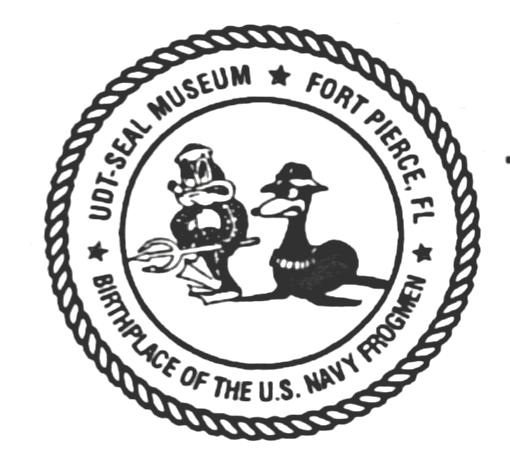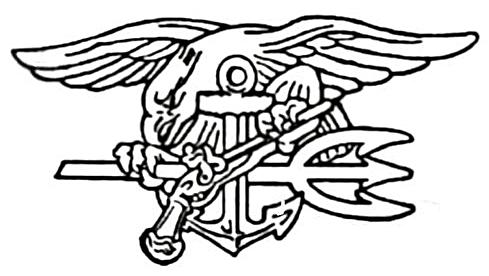[ History ]
|
[ Vietnam Review ] [PTF
06 ] [DaNang ] [Vulcan]
[Stalking ]
[Ngo The Linh ] [Murdoch ]
[MAC-V-SOG ] [Ads]
[UDT] [Book Review] [CRD-21]
UDT MUSEUM
Welcome to another unofficial UDT Museum webpage.
(Official Page Here:
http://www.navysealmuseum.com
) This past Winter I had the privilege to visit this fine museum while in
Southern Florida. I was in search for "PTF Nasty" stuff
and discovered this great collection of history that most of us
haven't even really consider the importance of. It is of medium size and I
am told that 40% of the artifacts are still stored away due to lack of
funds to expand their building.
Make a point of visiting the UDT Museum. The driving directions
from the Ft Lauderdale area are:
- North on I-95, take the Ft Pierce exit (#65) and proceed East on
Ochicobe Road to US-1.
- Travel North on US-1 until the A-1A North turn-off to the
first stop light.
- Turn left at the light (notice a Radisson Hotel on your right) and
travel 1/4 mile north.
- You won't miss it on the right hand side of the road.
NOTICE: Because they are very understaffed it is not practical
to answer Emails. They will answer telephone questions, but they are
unable to do research for you. Please visit in person and they will be
glad to assist you on site in anyway possible.
|
 |
UDT-SEAL Museum
|
|
|
|
The UDT-SEAL Museum was dedicated in November
1985. The addition was opened in November 1993.
The outside exhibits show the evolution of Naval
Special Warfare in the varied types of crafts used
from World War II to the 1980s, including the
museum's latest acquisition--a Seawolf helicopter
from the Vietnam era. Specialized equipment includes
swimmer delivery vehicles (SDVs) and swimmer
propulsion units (SPUs) and boats, such as the PBR,
a river patrol boat. Also on the grounds are
obstacles left from the early training days in Fort
Pierce and an Apollo spacecraft, a reminder of still
another area of involvement for the Navy's elite
forces.
An exhibit in the lobby pays tribute to Rear
Admiral Draper L. Kauffman, called the "Father
of Demolition," and includes some of his
personal memorabilia. The rest of the museum is
arranged in chronological order beginning with the
earliest training of the Naval Combat Demolition
Units and Scouts & Raiders in Fort Pierce in
1943 to Korea and Vietnam and even the most recent
SEAL Team involvement in Somalia in 1993 and Haiti
in 1994. In text, photographs, and artifacts,
exhibits trace the history of Naval Special Warfare
from the earliest "demolitioneer" to the
modern SEAL.
The museum has several exhibits dedicated to
weapons, including firearms of all types, and a
collection of Special Warfare knives. Both open- and
closed-circuit diving gear is on display, including
basic compressed air SCUBA tanks and closed circuit
gear, such as the Pirelli and Emerson rebreathers.
Other exhibits are dedicated to the varied equipment
used by the Navy's elite forces and to aspects of
life in the teams, such as training, operating in
cold climates, and involvement in America's space
program.
In a small viewing room visitors can see films
dealing with Basic Underwater Demolition/SEAL
(BUD/S) training, SEAL involvement in Vietnam and
Panama, interviews with people directly involved in
some aspect of Naval Special Warfare, and other
related subjects. The Ship's Store stocks T-shirts,
books, videos, and various mementos.
|
|
Tuesday-Saturday,
10 AM - 4 PM
Monday (Jan.-Apr.) 10 AM - 4 PM
Sunday, Noon - 4 PM
Admission: Adults $4.00
Children 12 & Under $1.50
Pre-Schoolers Free
Group Rates Available |
|
 |
|
3300 N. State Road A1A
North Hutchinson Island
Fort Pierce, Florida 34949-8520
Phone - (561) 595-5845
Fax - (561) 595-5847 |
|
|
|
|
A Brief History of Naval Special
Warfare
|
|
|
The U.S. Navy entered the underwater
demolition arena with the formation of a l7-man
detachment that spearheaded the invasion of
North Africa in November 1942. In 1943, another
group--Naval Demolition Unit One--opened
channels through Sicilian beaches. As the Navy
raised its sights for further attacks on both
European and Pacific targets, the need for
permanent clearance units became apparent. That
summer formalized training of 6-man Naval Combat
Demolition Units (NCDUs) began in Fort Pierce,
Florida.
In November, while being deployed in both
theaters, the amphibious invasion of the
Japanese-held island of Tarawa was to have
significant impact on the operational concept of
the NCDUs. During this invasion Marine- laden
assault craft ran aground on an uncharted reef.
While wading ashore, submerged depressions
became as lethal as enemy bullets as hundreds of
the men drowned. This disaster, plus the
prospective attack on Kwajalein, resulted in the
reorganization of future Pacific Fleet NCDUs
into 100-man Underwater Demolition Teams (UDTs)
and the incorporation of pre-assault
hydrographic reconnaissance as an integral part
of their demolition clearance mission.
While two UDTs were being organized in Hawaii
for the Kwajalein operation scheduled for
January 1944, the first NCDUs began arriving in
England in preparation for the Normandy
invasion. On the 6th of June they were among the
first to land on Omaha and Utah Beaches.
Sustaining overall casualties in excess of 40
percent, the surviving Omaha Force returned to
Fort Pierce, while the Utah Force redeployed to
England to participate in the invasion of
southern France. This was the last NCDU of the
war in
|
|
Europe and the last major invasion in which
demolitioneers were not swimmers. Also in June
1944 in the Pacific, Saipan was invaded with
five newly formed UDTs leading the way. From
this point on UDTs participated in every Pacific
island campaign from Borneo to Okinawa. By war's
end there were 30 teams with about 3,500 men in
all.
During the Korean War, UDTs were once again
called into combat. In addition to their classic
mission of pre-assault hydrographic
reconnaissance and clearance, UDTs conducted
night inland demolition raids against enemy
railroads, bridges, and tunnels, and served as
human mine sweepers in harbors and rivers.
In Vietnam UDTs shared their roles with
Sea-Air-Land (SEAL) Teams, formed in 1962 in
response to President Kennedy's stimulus to
expand the Navy's role in unconventional
warfare. SEAL Teams were made up of former UDT
personnel. For more than six years, SEALs
amassed an impressive combat record by
successfully interdicting major Viet Cong troop
and supply movements. For their size SEALs
emerged as one of the most highly decorated
units of the war, including three Congressional
Medal of Honor winners.
In 1983, the U.S. Navy converted all UDTs to
SEAL Teams and merged their missions. From their
early days in World War II as NCDUs and UDTs to
the present day SEALs, these elite combat units
have been in the forefront of every conflict,
contingency, and national emergency that has
faced the nation. Their history has been one of
accomplishment and pride, and the men who lived
it have given the UDTs and SEALs the undeniable
prestige which they enjoy today.
|
|
|
|
|
|
 |